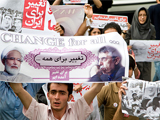Tehran’s Pyrrhic Victory
By Kamal Nazer Yasin for ISN
Starting with the third week of demonstrations following the June 2009 presidential elections, Iran’s protest movement had tried to appropriate every official national holiday or anniversary for its political goals.
The high-point mark of this clever strategy came on 27 December 2009, on the occasion of the Shia world’s most famous day of mourning, Ashua, when protesters managed to outmaneuver and disarm scores of Basij paramilitary personnel and anti-riot forces. Indeed, they even managed to take control of entire sections of Tehran for long commendable periods of time.
Although this came at the cost of several deaths and hundreds of arrests for the protesters, the psychological effect both for the government and the opposition was quite dramatic. The pictures of security personnel pleading pathetically to be set free by the protesters sent shock waves through the regime.
“Ashura represented the first moment in the Islamic Republic’s history when the government actually looked weak and pathetic,” one Iranian political activist who was briefly jailed by the government after the election told ISN Security Watch on condition of anonymity.
“The subduing of the repressive forces by the unarmed Ashura demonstrators especially on such a large scale had the potential to alter the larger dynamics at play. Something was bound to happen,” he said.
That “something” was a counter-demonstration hastily put together by the hard-liners on 30 December in the center of Tehran in which speakers called for the arrest of opposition leaders and, more ominously, the mass execution of detainees from the previous Ashura disturbances.
One speaker, Ayatollah Elmo’l Hoda, referred to Ashura protesters as “mohareb,” a Koranic juridical term about those who call war on God and who should be sentenced to death. Previous to this, word reached opposition circles that the hard right was organizing death squads whose tasks would have been to eliminate opposition Green leaders and their cadres without placing blame at the door of the real perpetrators. On 28 December, one such death squad actually came into existence.
On 9 January, under pressure from certain high clerics from the holy city of Qom, the Supreme Leader Ali Khamenei took a stand against this development.
"Any roguish activity helps the enemy," he told a visiting crowd from the holy city. "The involvement of those without legal status or responsibility only compounds the problem."
The result was the halting of the death squad-like activity and the continuation of the ongoing stalemate.
'A second national referendum'
For the Iranian regime, the 11 February revolution anniversary celebrations were a critical juncture. If it could regain lost ground, it could prove to domestic and international audiences that it remained in full control and that the protest movement was a spent force.
To achieve its objective, it had to ensure that protesters would not be able to congregate in large numbers and upstage the regime's well-choreographed processions. By 11 AM that day, in fact, it had become clear that the regime had indeed scored against the opposition, through an overwhelming display of force and the use of intimidation and terror tactics in the days preceding the event.
“People were bused in from hundreds of kilometers away,” a political activist who was closely monitoring the situation on 11 February told ISN Security Watch. “Anyone either working for the government or receiving perks from the regime was forced to attend.”
The result was the largest crowd gathered for an officially sanctioned occasion probably since the funeral of Ayatollah Khomeini nearly 20 years ago. In addition, security presence was augmented by bringing Basij militiamen from as far afield as Hamedan, some 640 kilometers away.
As for terror tactics, a campaign to intimidate and terrify potential protesters was put in practice over two weeks before the celebrations.
This campaign included the execution of two political prisoners, the first such executions carried out in a long time. Others also were given death sentences.
In addition, Tehran's police chief on several occasions went on record claiming that everyone's emails, telephone calls and text messages may be accessed, and that those engaged in anti-regime activities were to be immediately arrested. Other top law enforcement officers claimed that many people had been arrested based on photos taken of them during the Ashura protests. Indeed, a wave of arrests took place in the weeks before the ceremonies.
Moreover, those taking part in protests were now referred to regularly as "mohareb." Finally, the regime asserted that it would respond very harshly to those protesting.
The cumulative effect of these tactics was a lower turnout on the protesters’ side and a stronger hand on the government’s side. Some sympathetic newspapers called the event “a second national referendum.”
A pyrrhic victory
While the government will claim that it has defeated its adversary, there are reasons to believe that this has been a pyrrhic victory.
First, the protesters were simply prevented from massing on 11 February. They were not bruised to a level that the movement would taper off.
Second, the presence of tens of thousands of militiamen from the provinces has now helped spread news of unrest to the provinces; something the regime had tried hide to hide or belittle.
Third, and most importantly, the recession is now becoming much more severe than before. That, coupled with the massive cutting of state subsidies to enterprises, will cause huge layoffs in businesses and factories. This means that even if the government manages to keep the protests at bay for a while, it will not be able to stem the other structural problems it is facing.

